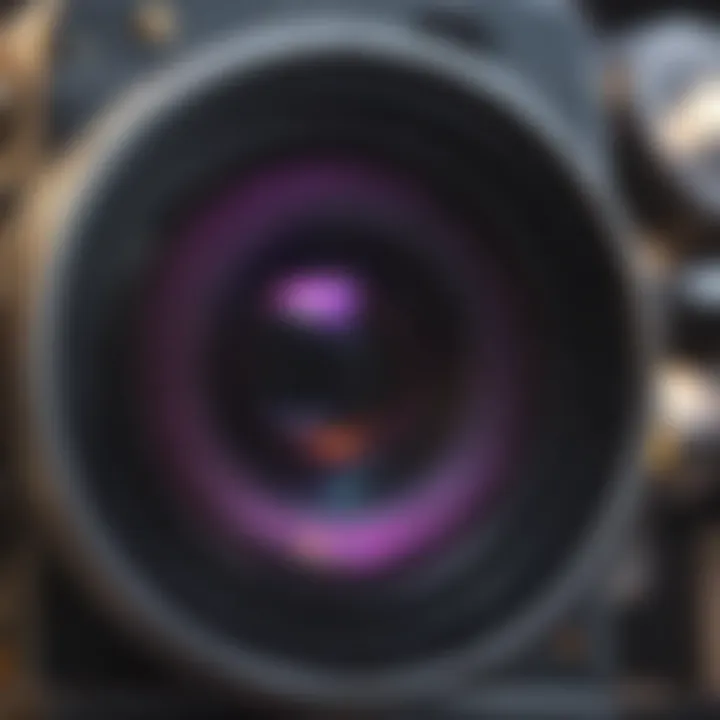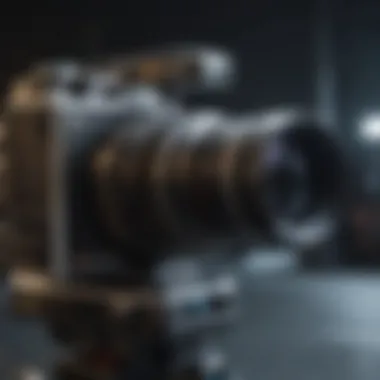Exploring High Speed Cinema Cameras: Technology and Impact


Intro
The study of high speed cinema cameras has become more than just a technical pursuit; it holds significance across multiple fields. This article aims to shed light on these remarkable devices, exploring their technological advancements and diverse applications. The impact of high speed cinema cameras extends from the realms of filmmaking to scientific research and industrial processes. As we explore the nuances of this technology, we will uncover its relevance and the challenges it brings.
Article Overview
Purpose of the Article
The primary purpose of this article is to give readers a comprehensive understanding of high speed cinema cameras. Readers will uncover how these cameras work, the technology behind them, and their relevance in various sectors. The intention is to present information that informs students, researchers, educators, and professionals about the capabilities and limitations of these cameras.
Relevance to Multiple Disciplines
High speed cinema cameras find applications in several disciplines:
- Film and Entertainment: Capturing high frame rates creates visually stunning moments that are pivotal in action sequences and special effects.
- Scientific Research: These cameras enable researchers to analyze rapid phenomena, such as biological processes, chemical reactions, and more.
- Industry: In manufacturing and quality control, high speed imaging is essential for monitoring processes that happen in the blink of an eye.
Research Background
Historical Context
The evolution of high speed cinema cameras is deeply rooted in the advancements of imaging technology. From the early film cameras to today’s digital innovations, each phase brought enhancements in speed, clarity, and control. Understanding this evolution provides critical insight into current devices and their capabilities.
Key Concepts and Definitions
Before diving deeper, it is important to clarify some key concepts and terms:
- High Speed Imaging: Refers to the capturing of rapid events at frame rates that exceed normal cinematic standards.
- Frame Rate: Measured in frames per second (fps), this is the speed at which consecutive images are captured and presented.
- Sensor Technology: Modern cameras often utilize advanced sensor technology that allows for better light capture in quick sequences, enhancing image quality.
Understanding these terms serves as a foundation for exploring more complex issues related to these cameras.
"High speed cinema cameras have revolutionized storytelling in film and provided scientists with tools to understand complex phenomena."
"High speed cinema cameras have revolutionized storytelling in film and provided scientists with tools to understand complex phenomena."
The integration of high speed cinema cameras into everyday applications only highlights their importance. The exploration of these devices reveals not only the technology but also the impact they have across different sectors.
Prelims to High Speed Cinema Cameras
High speed cinema cameras are essential tools in modern filmmaking and other fields. These devices enable the capture of rapid events in unprecedented detail and clarity. Understanding their significance and functionality is crucial for professionals and enthusiasts alike. In this section, we will explore their definition, historical context, and modern applications.
Definition and Overview
High speed cinema cameras are specifically designed to capture footage at frame rates significantly higher than standard cameras. While traditional cameras often operate at 24 to 30 frames per second, high speed cameras can shoot anywhere from hundreds to thousands of frames per second. This ability allows for slow-motion playback and detailed examination of fast-moving subjects.
The primary components of these cameras include advanced sensors and powerful processing units. The sensors convert light into electronic signals, while the processors handle the massive data generated during high-speed recordings. This combination of technology leads to stunning visual results, paving the way for innovative storytelling techniques in film and various industrial applications.
Historical Context
The evolution of high speed cinema cameras can be traced back to the early experiments in motion photography. In the late 19th century, inventors like Eadweard Muybridge pioneered methods to capture motion. However, it wasn’t until the advent of electronic imaging technology in the mid-20th century that high speed cameras began to take shape.
As technology progressed, cameras evolved from mechanical designs to electronic systems, allowing for faster and more reliable captures. By the 2000s, companies such as Phantom, Vision Research, and others introduced digital high speed cameras, which transformed the landscape of both film production and scientific research. Today, these cameras are ubiquitous, with applications extending beyond entertainment into various fields.
Significance in Modern Filmmaking


In contemporary filmmaking, high speed cinema cameras serve multiple purposes. Primarily, filmmakers use these cameras to create striking visual effects. Scenes with high action can be captured in detail, allowing for slow-motion sequences that engage audiences deeply.
Moreover, high speed imaging is vital in sports broadcasting. It provides viewers with intricate views of fast-moving sports events, enhancing the viewing experience. The usage of these cameras has also been critical in scientific research, particularly in areas that require observation of rapid phenomena, such as physics experiments or biological processes.
"High speed cinema cameras are not just tools; they are gateways to understanding the unseen world around us."
"High speed cinema cameras are not just tools; they are gateways to understanding the unseen world around us."
Overall, the introduction of high speed cinema cameras has revolutionized the possibilities of visual storytelling and analysis across multiple domains.
Technical Foundations
The technical foundations of high speed cinema cameras are essential for understanding how these devices operate and their relevance in various applications. A solid grasp of the mechanics, sensor technology, frame rates, and resolution allows filmmakers, researchers, and professionals to maximize the potential of high speed imaging. The interrelation of these elements shapes the effectiveness and capabilities of the cameras in practical use. This section elucidates these technical components, offering insights into their significance and the considerations surrounding each aspect.
Mechanics of High Speed Imaging
High speed imaging primarily relies on the intricate mechanics of shutter operation and light capture. The basic principle behind high-speed imaging is to record a large number of frames within a very short time. This process necessitates a robust mechanical design that can support rapid movement while ensuring stability.
Traditionally, high speed cameras employ a rotating shutter mechanism that can open and close quickly to capture fast motion without blur. However, advancements have introduced electronic shutter systems that can significantly reduce the duration of each frame while increasing the overall light sensitivity. The mechanics of these cameras not only provide a means to document fleeting moments but also reduce distortion and maintain clarity.
"The mechanical design of a high speed camera is crucial for precise motion capture and image quality."
"The mechanical design of a high speed camera is crucial for precise motion capture and image quality."
Sensor Technology
Sensor technology is a core component that determines the photoelectric conversion of the incoming light into digital signals. Two predominant sensor types used in high speed cinema cameras are CCD (Charge-Coupled Device) and CMOS (Complementary Metal-Oxide-Semiconductor). Each has its strengths and weaknesses that affect their applications.
CCD sensors are known for their superior image quality and light sensitivity, making them ideal for low-light conditions. On the other hand, CMOS sensors typically offer higher frame rates and lower power consumption, which can be beneficial in scenes demanding rapid image capture. This divergence in performance attributes demands careful selection based on specific shooting requirements and environmental conditions.
Certain high speed cameras also integrate global shutter technology. This approach allows all pixels to be exposed to light simultaneously, which eliminates motion artifacts common in rolling shutter systems, particularly during rapid movements. Understanding these sensor technologies aids users in making informed decisions that align with their imaging goals.
Frame Rates and Resolution
Frame rate refers to the number of individual frames captured in one second, and it plays a pivotal role in high speed cinema. Common frame rates for high speed cameras can reach thousands, even tens of thousands, of frames per second. This capability enables detailed slow-motion playback, allowing nuanced analysis of fast-moving subjects, whether in sports events or scientific research.
Resolution, on the other hand, denotes the amount of detail captured in each frame. Higher resolutions provide richer detail and a more immersive viewer experience, yet may also result in larger file sizes, presenting challenges in data management. Finding the right balance between frame rates and resolution is crucial in high speed imaging.
Filmmakers often select frame rates based on the nature of the action. For example, capturing a bullet fired might necessitate a frame rate of 100,000 fps, while a dancer's movements could be accurately depicted at 240 fps.
In summary, the technical foundations are critical to optimizing the functionality and applications of high speed cinema cameras. The mechanics of imaging, the evolution of sensor technologies, and the strategic alignment of frame rates and resolution all contribute significantly to the successful integration of these advanced tools into various fields.
Types of High Speed Cameras
Understanding the types of high speed cameras is essential for grasping how they cater to varied applications across industries. Each category of these devices serves specific purposes and comes with unique advantages and disadvantages.
vs CMOS Sensors
High speed cameras generally utilize two primary types of sensors: CCD (Charge-Coupled Device) and CMOS (Complementary Metal-Oxide-Semiconductor). Both have distinct operational characteristics that affect performance.
- CCD Sensors: These sensors often excel in image quality and low-light performance. They achieve this by capturing light and transferring it across the chip in a way that minimizes noise. However, CCD systems tend to consume more power and have slower readout speeds compared to their CMOS counterparts.
- CMOS Sensors: In contrast, CMOS sensors have gained popularity due to their lower power requirements and faster processing speeds. This allows for high frame rates while maintaining decent image quality. Moreover, their compact design often leads to a reduced cost, making them more accessible for various applications, from film production to scientific investigations.
Ultimately, the choice between CCD and CMOS sensors depends on the specific needs of the project. Understanding the nuances between these two sensor types helps professionals make informed decisions.


Portable vs Mounted Systems
In terms of application, high speed cameras can be categorized as portable or mounted systems. Each version has its own advantages.
- Portable Systems: These systems are compact and easily transportable, making them ideal for on-location shoots. They allow filmmakers to capture high-speed action without being tied to a specific setup. The convenience of portability is particularly beneficial in environments that require rapid repositioning of equipment.
- Mounted Systems: In contrast, mounted systems are fixed in place, usually designed for specific filming setups, such as studio environments. They can accommodate larger lenses and offer greater stability. This can result in higher quality captures, particularly in controlled settings, like sports events or scientific research labs.
Choosing the right system requires an understanding of the context. Portable systems afford flexibility, while mounted systems ensure stability and quality.
Specific Models and Their Features
When discussing high speed cameras, various specific models stand out due to their unique features and applications. Some of these models include:
- Phantom Flex4K: This camera is recognized for its superb video quality and flexibility in capturing high frame rates while maintaining 4K resolution. It is frequently used in both cinematic productions and scientific research.
- Vision Research Phantom VEO: Known for its remarkable dynamic range and robust build, this camera is suited for extreme conditions, such as sports and industrial inspections.
- Sony RX10 IV: While less conventional for professional films, this compact camera integrates high speed shooting capacity in a more user-friendly system. This makes it suitable for hobbyists and light professional use.
Each model provides distinct features that cater to different needs and settings. Knowing these details can help professionals select the most efficient camera for their specific projects.
Applications in Various Fields
High speed cinema cameras play a crucial role in various sectors, influencing how visual content is produced and analyzed. Their ability to capture rapid motion with exceptional clarity and detail opens up myriad possibilities in areas such as filmmaking, broadcasting, scientific research, and industrial applications. This section highlights the significance of high speed imaging technology in these fields, illustrating its benefits and considerations.
Cinema and Television Production
High speed cameras are indispensable in the realm of cinema and television production. With the demand for stunning visuals, filmmakers increasingly rely on these devices to create slow-motion sequences, which enhance storytelling and visual impact. High speed capture can bring a dramatic effect to action scenes, allowing viewers to witness details that would otherwise go unnoticed.
The advancements in sensor technology have improved the affordability and accessibility of high speed cameras. For instance, brands like Phantom and Sony offer cameras that allow filmmakers to shoot at frame rates exceeding 1,000 fps. This capability enables the creation of breathtaking visuals, enhancing audience engagement. Additionally, the flexibility of these cameras allows for creative shots in various lighting conditions, making them suitable for both indoor and outdoor settings.
Sports Broadcasting
In sports broadcasting, high speed cinema cameras are pivotal for capturing fast-paced action. These cameras allow broadcasters to analyze and replay critical moments from various angles, providing viewers with a clear understanding of the game dynamics. The ability to slow down plays adds a layer of depth to the viewing experience, making it more informative and engaging.
Moreover, high speed footage can be used for performance analysis by coaches and athletes. Advanced technologies such as the Global Appraisal of Individual Needs utilize high speed imaging to assess athletes' techniques, helping them improve their skills. As a result, high speed cameras have become a standard tool in sports, significantly enhancing both production quality and viewer experience.
Scientific Research
In the scientific research arena, high speed cameras are employed to investigate phenomena that occur over extremely short periods. From studying the motion of particles in fluid dynamics to the impact of material stress tests, these cameras provide invaluable data that traditional methods cannot capture. The precision of high speed imaging assists researchers in collecting accurate measurements and observing reactions in real-time.
For example, researchers in biomechanics utilize high speed cameras to analyze human motion, leading to advancements in sports science and rehabilitation. The detailed capture of motion helps in understanding complex interactions such as joint loading and muscle dynamics. Overall, the integration of high speed cameras in scientific research contributes to technological advancement by facilitating innovative studies.
Industrial Testing and Inspection
High speed cameras are also vital in industrial testing and inspection processes. In industries like manufacturing and automotive, these devices are utilized to monitor high-speed operations and detect failures or defects in processes and machinery. For instance, capturing the operation of assembly lines allows engineers to identify bottlenecks or equipment faults more accurately.
This technology not only improves product quality but also enhances safety protocols. With quick visual analysis, industries can ensure adherence to standards and regulations. Implementing high speed imaging systems helps reduce costly downtime and optimize production efficiency.
"High speed cameras are a bridge between art and science, revealing the unseen in both fields."
"High speed cameras are a bridge between art and science, revealing the unseen in both fields."
Challenges of High Speed Imaging
High speed imaging represents a fascinating convergence of cutting-edge technology and practical application. However, it is not without its own set of challenges. Understanding these obstacles is essential to grasp the full scope of what high speed cameras can achieve. The intricacies involved can significantly impact the adoption and effectiveness of these devices in various fields.
Cost Considerations


One of the most prominent obstacles associated with high speed imaging is the financial investment required. High speed cameras generally command a premium price. Unlike typical cameras, their specialized components and capabilities elevate their cost. For instance, models such as the Phantom Flex4K or the Vision Research Phantom v2511 are known for their exceptional frame rates and resolution, but this performance comes with a steep price tag.
This high cost can be a barrier for educational institutions and small production companies. Not only is the initial purchase price significant, but additional expenses for storage solutions, support equipment, and training can further complicate budgets. As a result, many users find themselves limited in their ability to leverage these powerful tools fully.
Data Handling and Storage
With the capacity to capture thousands of frames per second, high speed cameras generate substantial amounts of data. Handling this data poses a major challenge. Large video files require advanced storage solutions to ensure they can be processed and archived without losing quality.
The need for robust data management systems cannot be overstated. Improper handling can lead to file corruption or loss, which is particularly troublesome in fields like scientific research and film production, where the integrity of the captured data is critical. Furthermore, transferring these large files to editing systems demands high bandwidth, which can slow down workflows significantly.
Technical Limitations
Despite their capabilities, high speed cameras come with technical limitations that can hinder their performance. For example, many high speed cameras have reduced light sensitivity. When filming in low-light environments, this can result in poor-quality images or increased noise. Users may need to invest in advanced lighting systems to counteract this limitation.
Additionally, the sheer speed at which these cameras operate can lead to difficulties in synchronization and precise triggering. In applications where timing is crucial, such as capturing fast-moving objects, users often face challenges to ensure the camera is perfectly in sync with the subject’s motion.
The combination of cost, data management, and technical limitations shows that while high speed cameras offer unique capabilities, they also require careful planning and investment to utilize effectively.
The combination of cost, data management, and technical limitations shows that while high speed cameras offer unique capabilities, they also require careful planning and investment to utilize effectively.
Future Trends in High Speed Cinema Technology
The landscape of high-speed cinema technology is continuously evolving. As we navigate through the complexities of modern filmmaking and scientific research, understanding these trends becomes crucial. The integration of novel technologies not only affects how we capture fast events but also influences storytelling and analysis in multiple disciplines. The advancements in sensor technology, AI integration, and potential applications in virtual and augmented reality will shape the future of high-speed cinema significantly.
Innovations in Sensor Technology
Sensor technology is at the heart of high-speed imaging. Recent innovations have focused on enhancing the sensitivity and speed of sensors, allowing cameras to capture more details in rapid motion. Notable developments include the emergence of global shutter sensors, which solve the problem of motion distortion associated with rolling shutters. These devices can freeze fast-moving subjects without blurring. Additionally, improvements in dynamic range and color reproduction are allowing for higher quality images, even in challenging lighting conditions.
Moreover, sensors are becoming increasingly compact and power-efficient, making high-speed cameras more accessible. This shift enables smaller production companies to utilize high-speed technology that was once available only to major studios. The future promises a suite of innovative sensor designs that will redefine the boundaries of what high-speed cameras can achieve.
Integration with AI and Machine Learning
With the rise of artificial intelligence and machine learning, high-speed cinema technology is poised for transformative enhancements. AI algorithms can automate and optimize several aspects of the filmmaking process, including shot selection and scene analysis. For instance, real-time data processing via AI could allow systems to suggest adjustments during filming, improving the final output.
In addition, machine learning can enhance post-production processes. Automated editing tools can analyze vast amounts of footage and select the best frames based on defined criteria, saving time and effort. This integration not only streamlines workflows but also makes advanced filmmaking techniques more accessible to those with limited resources.
Potential in Virtual and Augmented Reality
The intersection of high-speed cinema technology with virtual and augmented reality presents exciting opportunities. High-speed cameras can capture intricate details of moving subjects, creating immersive experiences in virtual environments. This capability is essential for applications in gaming, training simulations, and educational tools.
Moreover, as virtual reality becomes more popular, content creators need to match user expectations for high-quality visuals in fast-paced scenes. High-speed cinema cameras are vital in producing content that is fluid and engaging, enhancing the realism of these immersive experiences.
Epilogue
In this final section, it is essential to reflect on the critical contributions and advancements of high speed cinema cameras within the scope of modern imaging technology. These devices have transformed how we capture fast-moving events and analyze intricate details that would otherwise be missed by the human eye. Their applications span various domains, from creative storytelling in films to precise measurements in scientific research and beyond.
Recap of Key Insights
High-speed cinema cameras are defined by their ability to record at incredibly high frame rates. This capability not only enhances visual storytelling but also provides extensive data for scientific analysis. Key insights into the evolution of sensor technology, types of cameras, and the challenges they face presented a comprehensive view of this specialized field. Moreover, the different uses of high speed cameras in cinema, sports, and industry illustrate their versatility.
The Importance of Progress in High Speed Imaging
Progress in high speed imaging is not merely a trend; it is a necessity. Technological evolution pushes the boundaries of what can be recorded and analyzed. Innovations in sensor technology, particularly advancements like global shutter and improved low-light performance, have opened new possibilities. Integration with AI and machine learning is also significant, offering tools for smarter analysis and enhanced user experience.
As industries increasingly rely on high speed imaging for accuracy and efficiency, the advancement of this technology becomes fundamental. Future directions hold the promise of further integration with virtual and augmented reality, amplifying the utility of high speed cinema cameras in various spheres.
"The ability to freeze the moment can lead to unparalleled insights and creations."
"The ability to freeze the moment can lead to unparalleled insights and creations."
In summary, the advancements in high speed cinema cameras fundamentally shape how we observe and understand rapid phenomena across multiple fields. As technology continues to advance, staying abreast of these developments is vital for professionals and enthusiasts alike. Understanding high speed imaging’s potential ensures that society maximizes the benefits these innovations bring.



